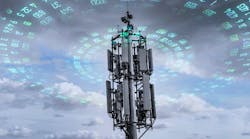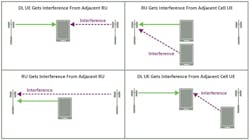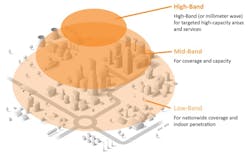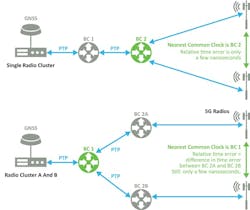This article is part of the TechXchange: It's About Time.
Members can download this article in PDF format.
What you’ll learn:
- How TDD technologies differ from their FDD predecessors.
- The critical nature of phase alignment in network infrastructure.
- Why common clocks provide an answer to aggregation-related phase-alignment issues.
The critical role of timing in 5G networks and its impact on network performance isn’t a subject that’s widely covered or examined in detail. This article will deliver insights into the role timing plays regarding the quality of the services being provided. The ways in which timing affects these services define the requirements of a proper timing architecture. Dive in to explore the fascinating concepts and intricacies of 5G timing architectures and technologies.
The source of time used to generate timing signals for 5G networking technologies is one that’s traceable to Universal Coordinated Time (UTC). Global Navigation Satellite Systems (GNSS) receivers are commonly used to obtain the UTC-traceable reference needed to satisfy the 5G timing requirements. Other technologies can also be used to obtain UTC traceable timing that aren’t mentioned in this article.
TDD Timing Requirements are Critical to 5G Networks
As LTE evolved from frequency-division-duplex (FDD) to time-division-duplex (TDD) technologies in 5G radio-access networks (RANs), new stringent timing requirements have emerged. FDD operation required only a frequency reference for frequency alignment of the RAN equipment, but TDD technology requires both a frequency reference and UTC-traceable phase reference.
The additional requirement of TDD technology is like the CDMA requirements in the RAN networks that were deployed several years ago. The CDMA base stations had integrated GNSS receivers to satisfy the timing requirements. One major difference between CDMA and 5G is that the CDMA base stations had high-quality rubidium atomic-clock oscillators for timing holdover functions if GNSS was compromised, whereas 5G base stations and radio technology don’t have rubidium atomic-clock holdover capability.
The 5G RAN technologies use low-cost, low-performance oscillator technology as a cost-saving measure. An important topic of this article is how this holdover-related vulnerability will be addressed in the overall timing solutions.
Single Frequency Bands for TDD
Both frequency- and phase-alignment requirements define how timing impacts 5G network performance. The internal clocks in the radios can hold the 50-ppb frequency requirement for several days, so losing the timing reference to the radio isn’t something that needs backup or to be addressed quickly. If the radio’s clock frequency drifts outside the 50-ppb accuracy window, the network will drop more calls when a radio hands off to an adjacent radio in mobility applications.
Phase alignment is a much more critical parameter. There are two different types of requirements: absolute phase alignment of a radio to UTC and relative phase alignment from radio to radio. First, let’s examine the role that timing plays in the category where the requirements for radio units (RUs) are ±1.5 µs to absolute UTC.
The 5G RAN technology is based on TDD that adds the absolute phase-alignment requirement to UTC in addition to the frequency requirements. In TDD operation, a single frequency band is shared for uplink and downlink transmission. Figure 1 shows the difference between FDD and TDD where the uplink and downlink for TDD share the same frequency band.
This means that transmission must be executed in assigned time slots. If the time slots overlap, the data transmitted in the time slots will be compromised, and, to some extent, related to interference. To prevent overlap, guard bands are placed around the time slots. These guard bands will at least partially absorb the offset in the event of timing errors. In 5G TDD networks, there’s a desire to reduce the size of the guard bands or eliminate them.
Timing Impairments Create Interference Issues
If the timing of the absolute requirement to UTC (±1.5 µs) is outside the specifications at the radio locations, this will result in interference between radios that share the same frequency spectrum. Timing errors result in degradation of service; for unregulated frequency bands, these can result in additional issues.
If multiple operators share the same spectrum, an operator with a timing issue can impact the service of a neighboring service provider operating with overlapping coverage. Figure 2 depicts interference scenarios for TDD applications.
The timing-related interference issues in TDD technologies elevate the role of timing in 5G networks to a critical status. It’s clear from the perspective of ITU and Open Radio Access Networks (O-RANs) standards that the possibility of timing-related interference makes preferable a network-based, Precision Time Protocol (PTP) timing architecture.
The 5G radios don’t have high-quality, high-performance oscillators that can hold time or phase for an extended period. When there’s loss of GNSS reception in a radio with an integrated GNSS receiver, that radio must be taken out of service quickly before it begins interfering with adjacent radios due to the lack of holdover quality.
Using network-based timing services, whereby the radios are connected to one source clock offering quality holdover, is a suitable mechanism to keep the radios in phase alignment if the GNSS timing receiver function in the source clock is compromised. If the GNSS is compromised in the source clock, all of the radios connected to the same source clock will drift in the same direction at the same rate, thus avoiding interference issues.
Common Clocks Support Relative Phase Requirements
The 5G carrier-aggregation feature introduces a relative phase-alignment requirement (as opposed to a UTC-traceable absolute phase-alignment requirement) between radios that operate at FR1 (Frequency 1: 4.1 to 7.125 GHz or sub-6-GHz) or FR2 (Frequency 2: 24.5 to 52.6 GHz or mmWave). Figure 3 depicts frequency-band coverage models for these spectrum segments.
The relative phase-alignment requirements for carrier aggregation are associated with the use of multiple component carriers that must be aggregated into the same frequency or multiple frequency bands. In the carrier-aggregation feature, it is possible for a user handset to connect to the same or multiple radios simultaneously using multiple component carriers.
The relative phase requirements for the use cases are typically met by the timing concept referred to as a common clock. For 5G radio clusters, the nearest common clock is a boundary clock (BC) function that’s located in the closest switch common to the adjacent radios in the cluster. Figure 4 depicts use cases for common clocks.
The carrier-aggregation feature will not operate properly if the radios aren’t phase-aligned within the specifications for the frequency band in which they operate. The common clock must be located where the relative time error that’s accumulated between the common clock and radio doesn’t exceed the time-error budget for the application.
A GNSS timing receiver used as a source clock, per the ITU standards, must operate within the Primary Reference Time Clock (PRTC) requirements, which are <100 ns of time error relative to UTC. It’s the best technical approach to use network-based PTP timing services that support the concept of the nearest common clock that could be either a PRTC or BC function.
Conclusion
The timing designs and architectures for 5G networks are important planning and engineering considerations when building out the footprints. Both absolute and relative timing requirements must be accounted for when deploying TDD wireless technology. Poor timing quality or not planning for timing failure scenarios can have service-affecting consequences such as issues related to interference and throughput.
Read more articles in the TechXchange: It's About Time.




